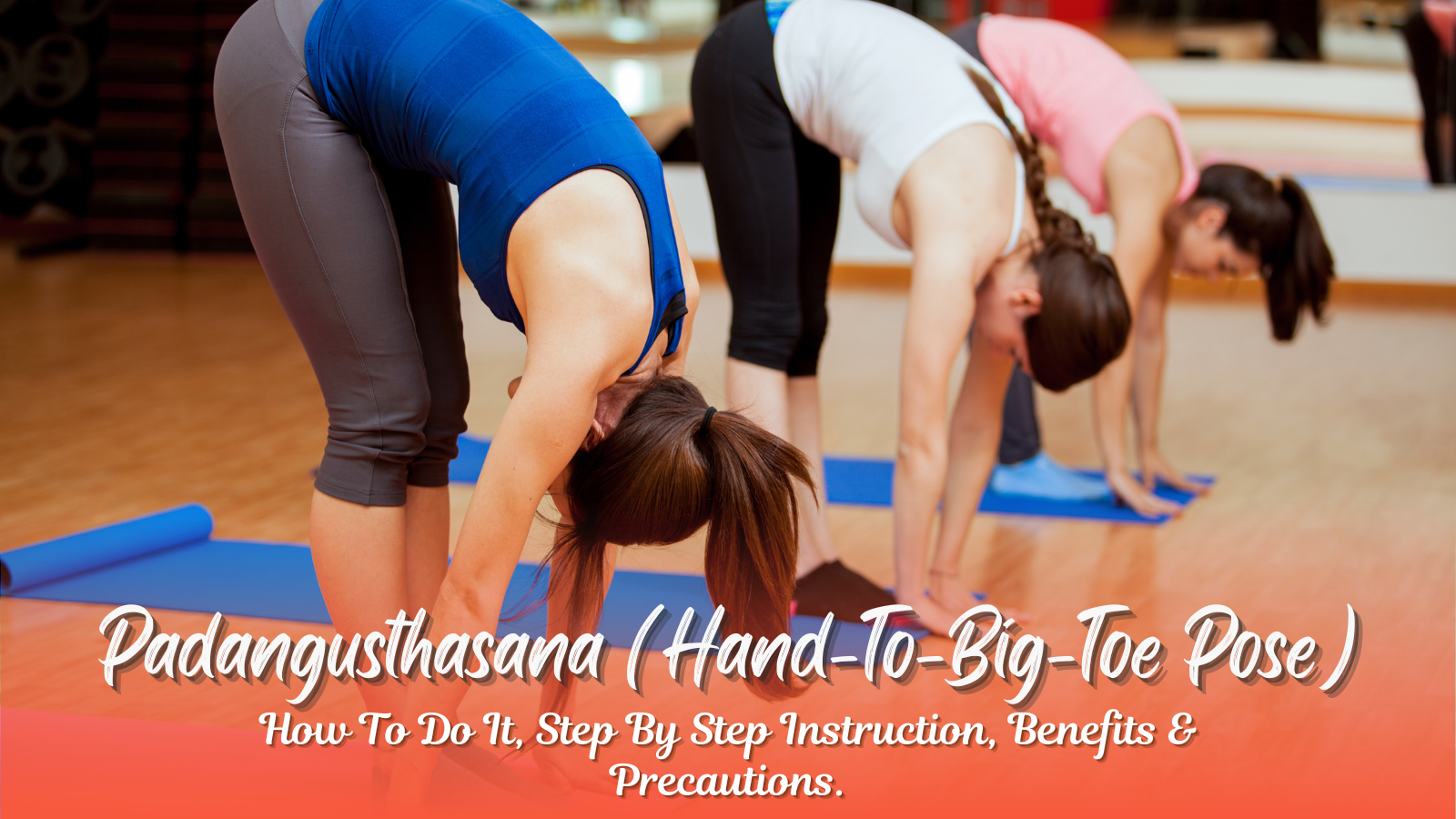Are you looking to improve flexibility, balance, and focus? Padangusthasana, or Hand-to-Big-Toe Pose, is an incredible yoga asana that enhances strength, stability, and mindfulness. Whether you’re a beginner or an advanced yogi, mastering this pose can deepen your practice and elevate your body awareness.
In this guide, we’ll explore:
✔️ What is Padangusthasana?
✔️ How to do Padangusthasana step by step
✔️ Different variations like Utthita Hasta Padangusthasana & Supta Padangusthasana
✔️ Benefits of Padangusthasana for body and mind
✔️ Common mistakes & modifications
So, let’s dive in and unlock the power of Padangusthasana!
What is Padangusthasana?
Padangusthasana (पादाङ्गुष्ठासन) comes from Sanskrit:
- “Pada” – Foot
- “Angustha” – Big Toe
- “Asana” – Pose
This standing forward bend involves holding the big toes with your fingers, helping to stretch the hamstrings, strengthen the legs, and improve balance. It is also a foundational pose for more advanced yoga postures like Utthita Hasta Padangusthasana and Supta Padangusthasana.
How to Do Padangusthasana (Step by Step Guide)
Follow these simple steps to practice Padangusthasana safely:
1️⃣ Starting Position (Tadasana – Mountain Pose)
- Stand tall with feet hip-width apart.
- Keep your spine straight, shoulders relaxed, and arms by your sides.
2️⃣ Forward Bend & Grip the Toes
- Inhale, engage your core, and slowly hinge forward from the hips.
- Keep your legs straight and bend as much as your flexibility allows.
- Hold your big toes with your index and middle fingers, wrapping your thumb around.
3️⃣ Deepen the Pose
- As you exhale, gently pull on your toes, bringing your chest closer to your thighs.
- Keep a micro-bend in the knees if you have tight hamstrings.
4️⃣ Hold the Pose & Breathe
- Hold for 30-60 seconds, breathing deeply.
- Keep your neck relaxed and focus on lengthening your spine.
5️⃣ Release & Return to Standing
- Inhale, engage your core, and slowly come back up to standing.
- Exhale and relax in Tadasana (Mountain Pose).
Variations of Padangusthasana
If you want to modify or advance your practice, try these variations:
1️⃣ Supta Padangusthasana (Reclining Hand-to-Big-Toe Pose)
- Lie on your back, extend one leg upward, and hold your big toe with your hand.
- This is excellent for hamstring flexibility and spinal alignment.
2️⃣ Utthita Hasta Padangusthasana (Extended Hand-to-Big-Toe Pose)
- Balance on one leg while extending the other straight forward.
- Enhances focus, core strength, and leg stability.
3️⃣ Ubhaya Padangusthasana (Both-Big-Toe Pose)
- Sit with legs extended, grab both big toes, and lift your legs off the floor.
- Strengthens the core and improves balance.
4️⃣ Hasta Padangusthasana (Hand-to-Big-Toe Forward Bend)
- A deeper version of Padangusthasana that requires advanced flexibility.
5️⃣ Parivrtta Hasta Padangusthasana (Revolved Hand-to-Big-Toe Pose)
- A twisting variation that enhances spinal mobility and balance.
Benefits of Padangusthasana (Why You Should Practice It)
Physical Benefits
✔ Improves flexibility – Stretches hamstrings, calves, and lower back.
✔ Strengthens legs & feet – Engages quadriceps and improves stability.
✔ Enhances balance & posture – Helps in standing tall with a strong core.
✔ Stimulates digestion – The forward bend massages abdominal organs.
✔ Relieves back pain – Decompresses the lower spine.
Mental & Emotional Benefits
✔ Reduces stress & anxiety – Encourages deep breathing and relaxation.
✔ Increases focus & concentration – Helps calm the mind.
✔ Boosts energy levels – Activates circulation and refreshes the body.
Common Mistakes & How to Fix Them
Rounding the Back → Keep your spine long and straight.
Locking the Knees → Always maintain a micro-bend in the knees.
Forcing the Stretch → Avoid pulling too hard; let flexibility develop naturally.
Not Engaging the Core → Activate your abdominal muscles for better balance.
Precautions & Who Should Avoid This Pose
Avoid if you have:
- Severe back pain or slipped disc
- Knee or hamstring injuries
- Dizziness or vertigo
- High or low blood pressure
If you have tight hamstrings, use a yoga strap around your toes for support.
Best Yoga Teacher Training in Rishikesh for Learning Padangusthasana
Want to deepen your yoga practice? Join the Best Yoga Teacher Training in Rishikesh, where you can learn Padangusthasana and other asanas in a structured course.
Top programs include:
📌 200 Hour Yoga Teacher Training Course in Rishikesh – Beginner-friendly training covering Hatha, Ashtanga & Vinyasa Yoga.
📌 300 Hour Yoga Teacher Training in Rishikesh – Advanced course for deepening asana, pranayama, and meditation.
📌 500 Hour Yoga Teacher Training in Rishikesh – Comprehensive certification for becoming a professional yoga teacher.
A Yoga Teacher Training School in Rishikesh is the best place to immerse yourself in authentic yogic wisdom and practice.
Benefits of Practicing Padangusthasana
Padangusthasana, also known as the Hand-To-Big-Toe Pose, is a popular yoga posture that offers numerous benefits for the mind, body, and soul. This pose may seem simple at first glance but has many deep-seated advantages that can enhance one’s overall well-being. In this section, we will explore the various benefits of practicing Padangusthasana.
1. Improves balance and stability: Maintaining balance and stability is crucial in our daily lives to prevent falls and injuries. Practicing Padangusthasana helps to improve proprioception (the awareness of one’s body in space) by strengthening the muscles in the feet, ankles, legs, and core.
2. Increases flexibility: The primary focus of Padangusthasana is on stretching the hamstrings and calves. Regular practice of this pose helps to lengthen these muscles and improve overall flexibility in the lower body.
3. Tones abdominal muscles: As you reach forward to grab your big toe in this pose, you engage your core muscles which help strengthen and tone them over time. Strong abdominal muscles not only give you a toned appearance but also support proper posture.
4. Stimulates digestion: The compression on the abdomen created by this pose massages the digestive organs, promoting better digestion and relieving constipation.
5. Relieves stress and anxiety: Holding onto your big toe while balancing on one leg requires concentration and focus which helps calm an overactive mind. The combination of physical movement with mindful breathing can reduce stress levels and promote relaxation.
6. Energizes the body: This standing pose requires effort from multiple muscle groups simultaneously, making it an excellent exercise for boosting energy levels throughout the day.
7. Stretches hips and thighs: In addition to targeting hamstrings and calves, Padangusthasana also stretches hip flexors (iliopsoas) which tend to become tight due to long periods of sitting.
8. Improves posture: Regular practice of this pose can improve posture by strengthening the muscles that support the spine and promoting proper alignment of the body.
9. Enhances focus and concentration: Balancing on one leg while maintaining a steady gaze can help to improve focus and concentration, which is beneficial in daily life as well as other physical activities.
10. Builds self-confidence: As with any challenging yoga pose, mastering Padangusthasana can boost self-confidence and leave you feeling accomplished and empowered.
Practicing Padangusthasana offers numerous benefits for both the body and mind. It is a versatile pose that can be modified for different levels of flexibility and strength. Include this pose in your yoga practice to experience its many advantages and improve your overall well-being.
Conclusion: Why You Should Practice Padangusthasana Regularly
Padangusthasana is a must-have pose in your yoga routine. It enhances flexibility, balance, and focus while relieving stress and tension. Whether you’re a beginner or an advanced practitioner, this pose will help you achieve greater mind-body awareness.
Tip: If you’re serious about mastering this pose, consider joining a yoga teacher training school in Rishikesh to refine your technique and deepen your understanding of yoga.
Start practicing Padangusthasana today and take your yoga journey to the next level!


